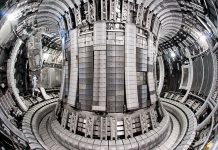The experimental Joint European Torus has doubled the record for the amount of energy made from fusing atoms — the process that powers the Sun.
A 24-year-old nuclear-fusion record has crumbled. Scientists at the Joint European Torus (JET) near Oxford, UK, announced on 9 February that they had generated the highest-ever sustained energy from fusing together atoms, more than doubling their own record from experiments performed in 1997.
“These landmark results have taken us a huge step closer to conquering one of the biggest scientific and engineering challenges of them all,” said Ian Chapman, who leads the Culham Centre for Fusion Energy (CCFE), where JET is based, in a statement. JET is owned by the UK Atomic Energy Authority, but it’s scientific operations are run by a European collaboration called EUROfusion.
If researchers can harness nuclear fusion — the process that powers the Sun — it promises to provide a near-limitless source of clean energy. But so far no experiment has generated more energy out than it puts in. JET’s results do not change that, but they suggest that a follow-up fusion reactor project that uses the same technology and fuel mix — the ambitious US$22-billion ITER, scheduled to begin fusion experiments in 2025 — should eventually be able to achieve this goal.
“JET really achieved what was predicted. The same modelling now says ITER will work,” says fusion physicist Josefine Proll at Eindhoven University of Technology in the Netherlands, who was not involved in JET’s research. “It’s a really, really good sign and I’m excited.”
Two decades’ work
The experiments — the culmination of almost two decades’ work — are important for helping scientists to predict how ITER will behave and will guide its operating settings, says Anne White, a plasma physicist at the Massachusetts Institute of Technology in Cambridge who works on tokamaks, reactors like JET that have a doughnut shape. “I am sure I am not alone in the fusion community in wanting to extend very hearty congratulations to the JET Team.”
JET and ITER use magnetic fields to confine plasma, a superheated gas of hydrogen isotopes, in the tokamak. Under heat and pressure, the hydrogen isotopes fuse into helium, releasing energy as neutrons.
To break the energy record, JET used a tritium fuel mix, the same one that will power ITER, which is being built in southern France. Tritium is a rare and radioactive isotope of hydrogen that, when fusing with deuterium, produces many more neutrons than do deuterium reactions alone. That ramps up the energy output, but using this fuel required JET to undergo more than two years of renovation to prepare the machine for the onslaught. Tritium was last used by a tokamak fusion experiment when JET set the previous fusion energy record in 1997.
JET contained two types of heavy hydrogen, deuterium and tritium, in fusion experiments performed last year.Credit: EUROfusion consortium
In an experiment on 21 December 2021, JET’s tokamak produced 59 megajoules of energy over a fusion ‘pulse’ of five seconds, more than double the 21.7 megajoules released in 1997 over around four seconds. Although the 1997 experiment still retains the record for ‘peak power’, it was over a fraction of a second and its average power then was less than half that of today, says Fernanda Rimini, a plasma scientist at the CCFE who oversaw the latest experimental campaign. The improvement took 20 years of experimental optimization, as well as hardware upgrades that included replacing the tokamak’s inner wall to waste less fuel, she says.
Power ratio
Producing the energy over a number of seconds is essential for understanding the heating, cooling and movement happening inside the plasma that will be crucial to run ITER, says Rimini.
Five seconds “is a big deal”, adds Proll, who works on an alternative fusion-reactor design called a stellarator. “It is really, really impressive.”
Last year, the US Department of Energy’s National Ignition Facility set a different fusion record — it used laser technology to produce the highest fusion power output relative to power in, a value called Q. The facility produced a Q of 0.7, where 1 would be breakeven — a landmark for laser fusion that beat JET’s 1997 record. But the event was short lived, producing just 1.9 megajoules over less than 4 billionths of a second.
JET’s latest experiment sustained a Q value of 0.33 for five seconds, says Rimini. At one-tenth of the volume, JET is a scaled-down version of ITER — a bathtub compared to a swimming pool, says Proll, and because it loses heat more easily it was never expected to hit breakeven. If engineers applied the same conditions and physics approach to ITER, she says, it would probably reach its goal of a Q of 10, producing ten times the energy put in.
Fusion researchers are far from having all the answers. A remaining challenge, for example, is dealing with the heat created in the exhaust region of the ITER reactor, which will increase in area compared with JET, but not proportionally with the surge in power it will have to deal with. Research is under way to work out which design would best withstand the heat, but they’re not there yet, says Proll.
The record-breaking run happened on the last day of a five-month campaign from which Rimini says scientists gleaned a wealth of information that they will analyse over the coming years. The final experiment pushed the device to its “absolute maximum”, adds Rimini, who witnessed the record-breaking test in real-time. “We didn’t jump up and down and hug each other — we were at 2 metres distance — but it was very exciting.”
doi: https://doi.org/10.1038/d41586-022-00391-1












































